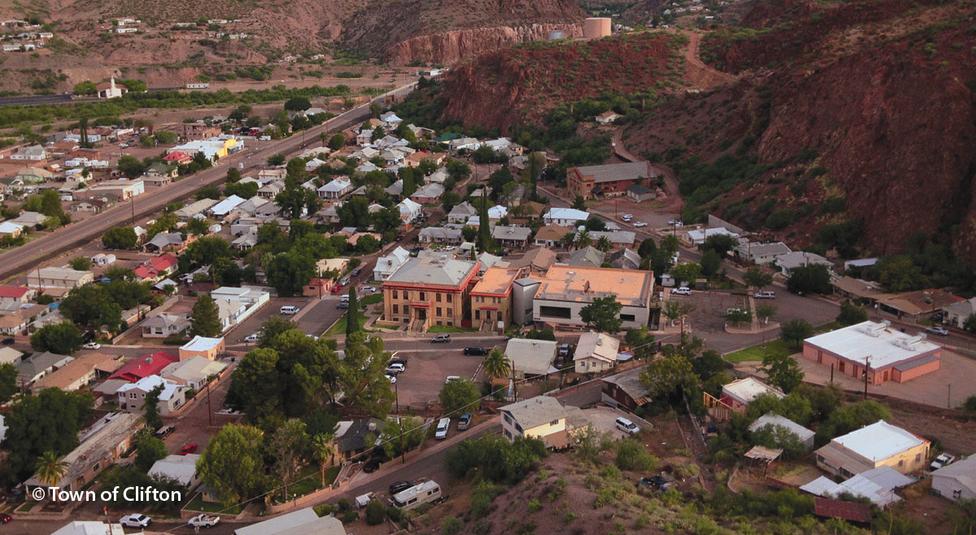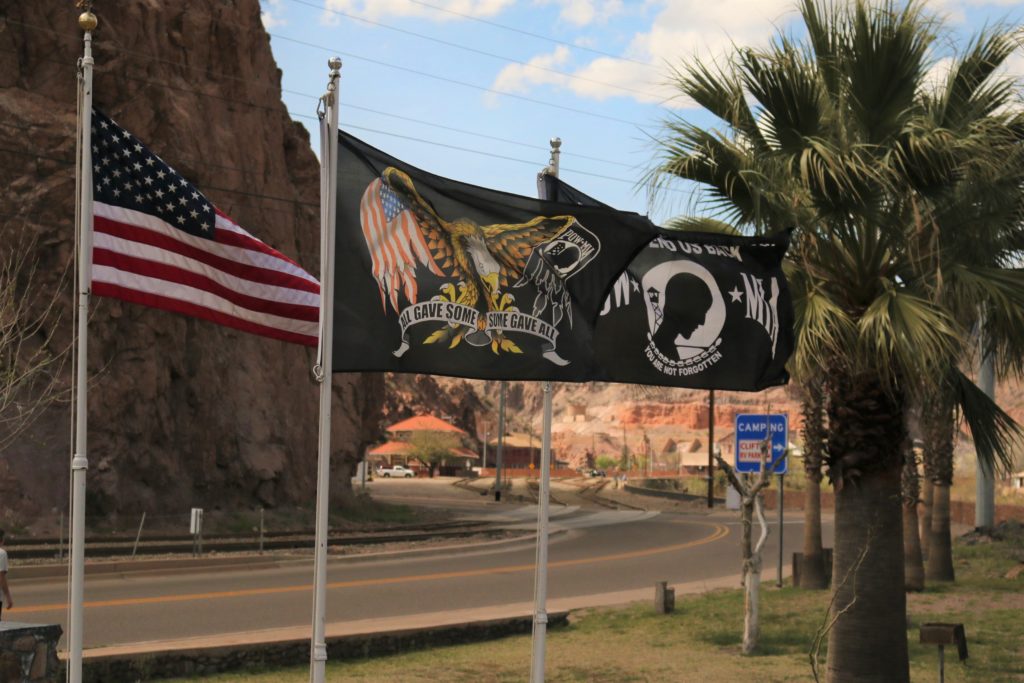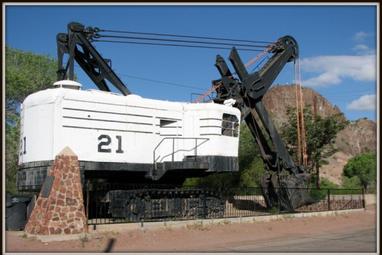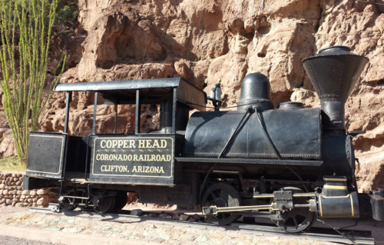Clifton, the Greenlee County Seat, is a blend of historical homes and modern residences perched within the canyon of the meandering San Francisco River. Due to this geography, Clifton is laid out in a linear fashion and has three distinct neighborhoods — South Clifton, East Clifton, and Chase Creek. (North Clifton used to be a major part of town, but the 1983 flood wiped it away.)

South Clifton
Here the valley is widest and permitted a substantial residential neighborhood punctuated by the County Courthouse near the top of the neighborhood on the east. The Clifton High School complex, now closed but used for training by Freeport-McMoRan, Inc. (FMI), can be seen west of US 191 (Coronado Blvd).
Ward Canyon branches off to the east at the far south end of South Clifton. Get to Ward Canyon by exiting west off Coronado Boulevard (US 191), near MP 162. The road immediately U-turns under the US 191 overpass to head east up the canyon. Ward Canyon Road features several activities. First, be thrilled by the curves and inclines while driving up or down the canyon, but please obey posted speed limits as the turns are deceptive and the terrain is unforgiving. Also, take note of the various types and colors of the rock formations. Hike to the Mares Bluff Veteran’s Memorial, Mulligan Peak, or the many trails accessed around the estate communities of Loma Linda and Verde Lee just beyond the top of Ward Canyon.

East Clifton After you pass through the flood gates and cross the bridge over the San Francisco River, you enter East Clifton. The west side of the river is mostly highway, train tracks, an RV park, the Rode Inn Motel, and the famous Clifton Train Depot, where the Clifton Visitor’s Center is housed, and the American Legion. The east side has one major street, Park Avenue, on which one can find the Blue Door Sanctuary, the FMI Guest House, soccer field, Splash Pad, residences mostly on the canyon walls, the Clifton Hotel, and the Mining Shovel display.
>>
The FMI Guest House, originally the Arizona Copper Company Manager’s House, is a beautiful craftsmen-style, two-story residence. It is the largest and the most stylistically pure structure in Clifton.

>>
The Mining Shovel Display is a heavy-duty mechanical shovel that was state-of-the-art decades ago. It was installed by volunteers from the Morenci mine in the 1990’s. The shovel is situated in east Clifton adjacent to the Zorilla Street Bridge. Small by current standards, the shovel provides an insight to evolving copper mining
technology.
The Zorilla Street Bridge spans the San Francisco River and connects Coronado Blvd (US 191) on the west side with Park Avenue on the east side. For a long time it was the only link between the east and west sides of town. It is a “through truss” bridge, built in 1918, and is listed on the U.S. National Register of Historic Places. It has also been known as Clifton, Riley and Park Avenue Bridge.

>>
Historic Copper Head Locomotive & Clifton Cliff Jail are both must-see attractions while exploring the Clifton Historic District. This Coronado Railroad locomotive sits next to the Clifton Cliff Jail on Coronado Boulevard (US 191). This Porter steam locomotive became the first operational railroad in Arizona and hauled ore from mines around Morenci and Metcalf in the mountains above to the smelter near where Chase Creek met the river. The locomotive was brought to Clifton in parts by wagon train and reassembled. The Clifton Cliff Jail, the original town jail, was blasted from solid rock and built into the side of the cliff in 1881. It is now part of the Clifton Historic District. It is the most unique incarceration facility in the United States. Visitors can enter either of the two cells to experience the conditions of Old West justice.

Clifton Train Depot & Visitor Center is the best stop for information while exploring Clifton and the surrounding area. Located in the heart of Clifton in the historic train depot, friendly volunteers will provide you with a list of places to see, things to do and other valuable information so you can make the most of your visit. The Historic Clifton Train Depot was built in the 1910’s and is still an iconic piece of architecture today. Plan a visit to this beautiful historical site which is now the Arizona Office of Tourism site in Greenlee County. Open Monday through Saturday, 10:00am to 2:00pm. 100 N Coronado Boulevard, Clifton. For more information call the visitor center (928) 865-3313.
>>
Bighorn Sheepgrace the cliffs, hills and mountains of Clifton-Morenci, courtesy of the Arizona Fish and Game Department. The wild sheep are expanding into the surrounding habitat, naturally wandering throughout Greenlee County’s areas. Effortlessly scaling the seemingly impossible sheer cliffs in search of feed along the roads, the sheep make great photo opportunities, often without leaving your vehicle. Keep your eyes open, as they blend in on a cliff nearby, they appear as if out of nowhere and are fond of overseeing local outdoor events.
To the north of the Zorilla Street Bridge about
three miles is Potter Ranch, a historic ranch house built in 1901 that is now listed on the National Register of Historic Homes. The Spanish Mission revival style home, erected by Dell Potter, an early mining entrepreneur, remained in the Potter family until 2019. Today it is a private residence. Located at 502 Potter Ranch Lane, it is about 2 miles north of the North Clifton RV Park. Cross the Polly Rosenbaum Bridge north of the RV Park and continue along the unpaved San Francisco River Rd. and view the home from San Francisco River Rd.
Chase Creek
As Coronado Blvd turns west between the small rock butte and the cliffs, you enter Chase Creek. Here you find the Chase Creek Historical District, the Circle K, Post Office, Town Hall, several businesses, and many residences.
Chase Creek Historical District and its encompassing buildings were constructed along the narrow Chase Creek. With access to water, a railroad, and with the smelter, Clifton grew rapidly to become the mining district’s main hub. Clifton and its Chase Creek Street quickly earned an unsavory reputation as one of the wildest camps in the West, second only to Tombstone. After fires in the early 1900’s destroyed many of the wooden buildings, all structures were built with brick, generally in the neoclassical style referred to as Territorial architecture in Arizona. Explore the delightful shops and amazing buildings of the Chase Creek Historical District and experience its everlasting charm. The Arches on Chase Creek stand alone and often puzzle visitors. They are the remnants of the Lyric Theater, destroyed by fire in the 1960’s. In its day the Lyric offered entertainment to the gentle population, and to the rough miners who also visited the 24-hour saloons, gambling halls, and bordellos. The Greenlee County Historical Museum on Chase Creek St offers pamphlets for a walking tour of this street, or for an electronic copy on your mobile device, visit www.cometoclifton.com. Then select ‘See And Do’ and ‘Chase Creek Historic Walking Tour.’
>>
Greenlee Historical Museum within Clifton’s Chase Creek Historical District, hosts exhibits under the direction of the Greenlee County Historical Society. The building itself, a fine example of period architecture, is listed on the National Register, was built in 1913 by the Spezia Brothers, and began it’s own history as a warehouse. The museum displays a wealth of Greenlee County history, including Native American artifacts, Arizona Territory history, but foremost it features the early mining days of the Clifton-Morenci Mining District. Admission is free to the public, and the building is handicapped-accessible. Located at 299 Chase Creek Street. Museum currently open from 2:00pm – 4:30pm on Thursday and 10:00am – 4:30pm on Saturday, or for a visit during other days/times call Joe (928) 215-0829 or Linda (928) 965-2463
<